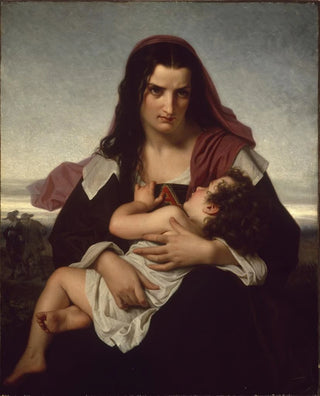Art print | The Scarlet Letter - Hugues Merle


View from behind

Frame (optional)
In the fascinating world of 19th-century painting, the "Reproduction" of "The Scarlet Letter" by Hugues Merle stands out for its narrative depth and exploration of themes of shame and redemption. This canvas, which evokes intense emotions, is inspired by the famous novel by Nathaniel Hawthorne, immersing the viewer in a story where the weight of social conventions heavily burdens the individual. The scene, imbued with melancholy, invites us to reflect on the consequences of our choices and on human nature, while immersing us in a rich historical context filled with tension.
Style and uniqueness of the work
Merle's style is characterized by poignant realism, where every detail is carefully crafted to convey an atmosphere charged with emotion. The color palette, subtly chosen, oscillates between warm tones and deep shadows, creating a striking contrast that emphasizes the dramatization of the scene. The expressions of the characters are particularly evocative, revealing complex states of mind and inner conflicts. The composition of the work, with its play of light and depth, guides the viewer's gaze, inviting them to lose themselves in the thoughts of the protagonists. This painting does not merely depict a story; it lives and breathes it, engaging the viewer in an introspection on universal themes of love, suffering, and judgment.
The artist and his influence
Hugues Merle, a French artist of the 19th century, is often recognized for his skill in capturing moments of life imbued with sensitivity. Trained at the École des beaux-arts in Paris, he skillfully drew on influences from Romanticism and Realism to forge a unique style. Merle is distinguished by his ability to approach delicate subjects with a touch of poetry, addressing social and moral themes that still resonate today. His work, although sometimes overshadowed by his contemporaries, marked his era and continues to inspire many artists. By tackling societal issues through visual narratives, he paved the way for reflection on individuality and the human condition, making him an essential figure in

Matte finish

View from behind

Frame (optional)
In the fascinating world of 19th-century painting, the "Reproduction" of "The Scarlet Letter" by Hugues Merle stands out for its narrative depth and exploration of themes of shame and redemption. This canvas, which evokes intense emotions, is inspired by the famous novel by Nathaniel Hawthorne, immersing the viewer in a story where the weight of social conventions heavily burdens the individual. The scene, imbued with melancholy, invites us to reflect on the consequences of our choices and on human nature, while immersing us in a rich historical context filled with tension.
Style and uniqueness of the work
Merle's style is characterized by poignant realism, where every detail is carefully crafted to convey an atmosphere charged with emotion. The color palette, subtly chosen, oscillates between warm tones and deep shadows, creating a striking contrast that emphasizes the dramatization of the scene. The expressions of the characters are particularly evocative, revealing complex states of mind and inner conflicts. The composition of the work, with its play of light and depth, guides the viewer's gaze, inviting them to lose themselves in the thoughts of the protagonists. This painting does not merely depict a story; it lives and breathes it, engaging the viewer in an introspection on universal themes of love, suffering, and judgment.
The artist and his influence
Hugues Merle, a French artist of the 19th century, is often recognized for his skill in capturing moments of life imbued with sensitivity. Trained at the École des beaux-arts in Paris, he skillfully drew on influences from Romanticism and Realism to forge a unique style. Merle is distinguished by his ability to approach delicate subjects with a touch of poetry, addressing social and moral themes that still resonate today. His work, although sometimes overshadowed by his contemporaries, marked his era and continues to inspire many artists. By tackling societal issues through visual narratives, he paved the way for reflection on individuality and the human condition, making him an essential figure in






